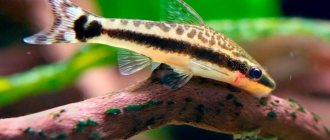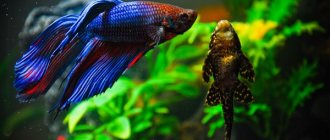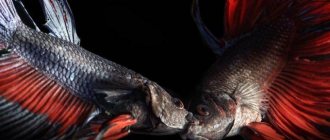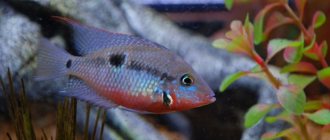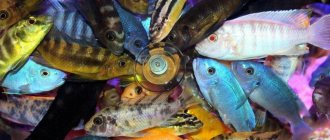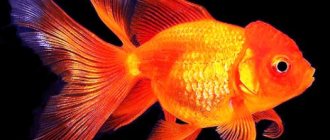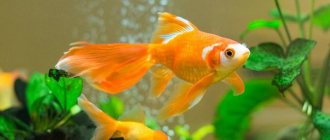Iodinol is an antiseptic disinfectant produced in the form of a dark blue liquid. It is used for diseases such as periodontitis, otitis, tonsillitis, as well as for thermal or chemical burns of varying degrees of severity. But besides this, “Iodinol” is also used in aquarium farming . This is a kind of adjuvant for therapeutic or prophylactic purposes. More details about the use of “Iodinol” for aquariums will be discussed in this article.
"Iodinol" to combat ichthyophthyriosis and other diseases in fish
Chemical composition
The effectiveness of the antiseptic drug is due to its rich chemical composition.
"Iodinol" includes the following components :
- polyvinyl alcohol (PVA);
- potassium iodide;
- purified water;
- iodine as an active substance.
Basic information about the drug
The combination of such elements allows potassium “Iodinol” to actively fight ichthyophthyriasis and other diseases in fish.
Corydoras Spawning
As a rule, spawning begins in the early morning. The male pushes the female with his antennae, tickling her back and sides. Then it turns at right angles to the female’s head and releases the seed.
Experts cannot definitively agree on how eggs are conceived. Some suggest that the female, passing the seed through the intestinal tract, releases it onto the eggs located in the ventral fins. Another part believes this: the seed passes only past the female’s gills, and is sent along the longitudinal direction of the body to the egg.
When conception is complete, the female glues the egg onto a previously cleaned surface. Immediately after the eggs are laid, the mating process is resumed until all two hundred to three hundred eggs have been fertilized. This may take an hour or more. As a result, to breed corydoras, it is only necessary to provide them with proper living conditions.
Benefits of use
Aquarists often use Iodinol because this drug has a number of advantages:
- strengthening the immune system;
- increasing the level of iodine in aquarium water;
- providing an antiseptic effect on fish;
- saturating the plants in the aquarium with potassium, thereby improving their general condition;
- reducing the likelihood of fungal infection (a higher percentage of eggs and fry ).
Shrimp in an aquarium
Note! “Iodinol” facilitates the molting process of crustaceans . This is due to the presence of iodine in the composition of the drug, which is needed for the production of chitin .
Hexamitosis, or hole disease
Fin rot in aquarium fish
Why do fish die in an aquarium?
White small worms on the glass of an aquarium
What fish and plants can do without a filter and compressor?
Since by-products of fish life are used by plants for vegetation, in an aquarium where a whole school is swimming, it is recommended to plant plants with rapid growth. They prevent the development of voracious bacteria and maintain water clarity. The list of friends of an aquarist who does not yet know how to care for an aquarium without a filter includes such popular species as elodea, vallisneria, some types of ferns (except the Thai one), echinodorus, hornwort, cabomba, ludwigia, and bacopa.
Fish that can be placed in aquariums without a filter usually belong to the loaches, labyrinths, and catfishes. This is first of all:
- speckled catfish;
- macropods;
- acanthophthalmus;
- battles;
- Siamese fighting fish, or cockerels;
- all types of gourami;
- lalius;
- guppy;
- zebrafish;
- neons;
- small goldfish;
- barbs;
- swordtails.
Indications for use
“Iodinol” is equally important for any aquarium, be it a small herbal tank or a luxurious African cichlid. The drug is important for all types of organisms living in water. “Iodinol” is actively used not only as a therapeutic agent, but also for preventive purposes (it strengthens the immunity of fish, making them more resistant to various diseases).
Aquarium with plants
On a note! Iodinol is also used as a conditioner for aquarium water. The drug saturates the water with useful substances, thereby improving aquarium life.
"Iodinol" is a dark blue liquid
Introduction
I think it’s not worth describing in detail the filtration process in an aquarium here. Let's just get the basics straight. It is known that there are several types of filtration in an aquarium: mechanical, chemical and biological. With mechanical filtration everything is relatively simple. This is the removal of large particles of dirt from water, chemical removal of unwanted elements dissolved in water, including medications after treatment of fish. Using special adsorbents. What remains is biological filtration. This is a simplified version. Decomposition of harmful substances accumulating in the aquarium during the life of the aquarium inhabitants with the help of various bacteria.
For biological filtration, external filters are used that are quite expensive compared to other aquarium equipment. They come in various designs, the most common being external canister-type filters. The main function of the filter is to provide space for the filter media to fill. On the surface and inside of which the very bacteria settle, with the help of which harmful substances are decomposed into less dangerous ones. Is it possible to make an aquarium without a filter, and discard the filter without harming the aquarium itself?
To answer this question. We need to figure out where else besides the filters these beneficial bacteria can settle. In fact, they are spread throughout the entire aquarium. Regardless of whether there is a filter in the aquarium or not. Colonies of bacteria settle on the walls of the aquarium, plants, decorations and the largest colonies, on the ground and inside it. Accordingly, by installing a filter, bacteria are only provided with additional area and conditions are created for their reproduction and, therefore, the effective performance of their functions in processing harmful substances.
Instructions
Iodinol should be used for therapeutic and prophylactic purposes at the rate of 10 ml of the drug per 100 liters of aquarium water . This dosage is safe for all fish. “Iodinol” should be added to the aquarium for 3-4 days, but after that the product should be used once every 3 days. When applying high dosages you need to be extremely careful. It is better to add the drug in stages, dividing the medicine into several parts.
Note! When using Iodinol, you should always have clean water ready to replace and change the concentration of the drug in the aquarium.
When using Iodinol, you should always have clean water ready for water changes.
It is recommended to use the drug in the indicated dosage when identifying small fish abrasions or as an addition to traditional therapy. For example, when treating semolina , the drug can be used in combination with other drugs. In this case, “Iodinol” will enhance the healing properties of the main drug.
Tetra General Tonic Tetra Contralck Sidex Tetra Bactozyme Tetra Vital Tetra NitrateMinus Tetra AquaSafe Hydrogen Peroxide
How to get rid of mucus in an aquarium and where does it come from?
“Algae slime” in an aquarium is a problem not only for beginner aquarists, but also for experienced aquarium owners. Getting rid of this problem is quite difficult. To begin with, “algae slime,” as it is most commonly called, is a misnomer. In fact, this mucus is formed due to Cyanobacteria and they are not exactly algae, but something more harmful between algae and bacteria, but most often they are called “blue-green algae”. Cyanobacteria are bacteria that produce their own food and live in colonies large enough for you to see. It is these colonies that are the problem for aquarists. Their color is not necessarily blue-green, it can be black, blue, and dark red. They are capable of covering huge areas of the aquarium. The first thing that aquarists want when they find colonies of cyanobacteria in their aquarium is to get rid of them immediately. This is where the difficulties begin. In order to get rid of the problem, you need to determine the color of cyanobacteria and choose the right treatment. There are chemicals that, when added to aquarium water, will dissolve such contaminants, but this does not mean that the problem will not return after a while. What’s most unpleasant is that relapse is usually much worse.
Any uncontrolled growth of bacteria or algae indicates that there is an imbalance in the aquarium system. To prevent this problem from affecting you, pay attention to important aspects.
Aquarium dirt, fish waste, uneaten food and much more are excellent “feeding” for bacteria. Clean your aquarium on time, provide it with a high-quality filtration system, and change the water in a timely manner.
An important aspect is aquarium lighting. Lighting is a source of food for algae, so if you are a beginner aquarist, choose your lighting under the guidance of a professional.
So, we have found out the reasons for the appearance of mucus. How to get rid of it?
Monitor the cleanliness of the aquarium. Change the water, provide high-quality filtration, install a high-quality skimmer. A low-quality skimmer will result in an aquarium infested with bacteria and waste. Here's a great rule: when you buy a skimmer, don't buy it based on the amount of water in your aquarium, but twice that amount. This way all waste will be removed in a timely manner. Use only high quality filters.
Replace lamps in a timely manner, do not wait until they burn out. Don't replace them all at once, but gradually, but if the mucus persists, you may have to change your lighting system entirely.
Monitor your feeding. Feed the fish once a day, or divide the daily norm into two times. Do not give more food than required. For feeding, it is better to use granules or special chips.
If you keep a freshwater aquarium, then in addition to the above procedures, you can recommend a high-quality carbon filter, proper light and control of water changes.
Remember: slime in your aquarium does not mean that you are a bad aquarist - even professionals encounter cyanobacteria deposits. The most difficult thing in solving this problem is finding the cause. This is a long period of struggle, very difficult. You may be offered various chemicals that will get rid of cyanobacteria almost instantly, however, as we said earlier, everything will repeat itself until you find the cause of the problem.
Caring for fry
As soon as the fry have appeared, they are first fed with the yolk sac of the eggs. Then their further food turns out to be ciliates and special dry food for fry or regular food, but crushed into powder form.
After one to one and a half weeks, larger amounts of live food can be included in the diet.
Now you have learned that breeding catfish is not that difficult. This is also feasible for amateur aquarists. Provide your fish with good conditions for fertilization, a complete diet, and nature will take care of the rest.
What affects the effectiveness of treatment?
The key to a successful fight against ichthyophthirius is the strict use of preventive and medicinal products. In addition, the environment created in the quarantine aquarium affects the speed of recovery. It must meet the following criteria:
- The water temperature in the first few days is maintained at 32-34°C, then gradually decreases to normal. It is important that there are no sudden changes in the aquarium - they will negatively affect the well-being of the fish.
- There should be no soil, plants or other objects in the aquarium. Firstly, nascent ciliates can live in them if the object was previously in an infected aquarium. Secondly, this way you will protect the fish from injuries that it can inflict on itself while trying to get rid of the itch. It is better to calm it down by other means.
- Aeration needs to be increased these days - the fish need constant fresh oxygen.
- Minimum stress and irritants. Rest is the best medicine not only for humans, but also for other living beings. The fish should be kept in comfortable conditions until complete recovery.

